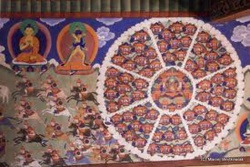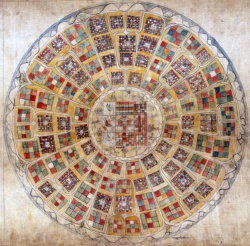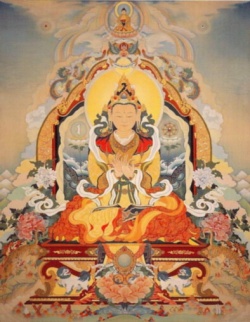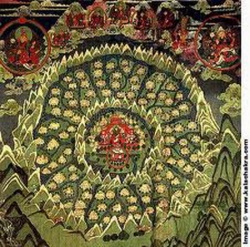Shambhala
In Tibetan Buddhist and Indian Buddhist traditions, Shambhala (also spelled Shambala or Shamballa; Tibetan: བདེ་འབྱུང་; Wylie: bde 'byung, pron. De-jung) is a mythical kingdom hidden somewhere in Inner Asia.
It is mentioned in various ancient texts, including the Kalachakra Tantra and the ancient texts of the Zhang Zhung culture which predated Tibetan Buddhism in western Tibet.
The Bön[3] scriptures speak of a closely related land called Olmolungring.
Whatever its historical basis, Shambhala gradually came to be seen as a Buddhist Pure land, a fabulous kingdom whose reality is visionary or Spiritual as much as physical or geographic.
It was in this Form that the Shambhala myth reached the West, where it influenced non-Buddhist as well as Buddhist Spiritual seekers — and, to some extent, popular culture in general.
In the Buddhist Kalachakra teachings
Sambhala (this is the Form found in the earliest Sanskrit manuscripts of Kalachakra texts; the Tibetans usually transliterated this as "Shambhala"; Tib. bde 'byung) is a Sanskrit term of uncertain derivation.
Commonly it is understood to be a "place of peace/tranquility/Happiness".
Shakyamuni Buddha is said to have taught the Kalachakra Tantra on request of King Suchandra of Shambhala; the teachings are also said to be preserved there.
Shambhala is believed to be a society where all the inhabitants are Enlightened, actually a Buddhist Pure land, centered by a capital city called Kalapa.
The Buddhist myth of Shambhala is an adaptation of the earlier Hindu myth of Kalki of Sambhala found in the Mahabharata and the Puranas.
The Buddhist version may be a mythologization of an actual culture, whose geographical location can be found either in Central or Far Eastern Asia (China).[citation needed]
Shambhala is ruled over by Lord Maitreya.
The Kalachakra prophesies that when the World declines into War and Greed, and all is lost, the 25th Kalki king will emerge from Shambhala with a huge army to vanquish "Dark Forces" and usher in a worldwide Golden Age.
Using calculations from the Kalachakra Tantra, scholars such as Alex Berzin put this date at 2424 AD.
Manjushri Yashas (Tib. Rigdan Tagpa) is said to have been born in 159 BC and ruled over a kingdom of 300,510 followers of the Mlechha (Yavana or "western") Religion, some of whom worshiped the sun.
He is said to have expelled all the heretics from his dominions but later, after hearing their petitions, allowed them to return.
For their benefit, and the benefit of all living beings, he explained the Kalachakra teachings.
In 59 BC he abdicated his throne to his son, Puṇdaŕika, and died soon afterwards, entering the Sambhogakáya of Buddhahood.
As with many concepts in the Kalachakra Tantra, the idea of Shambhala is said to have "outer", "inner", and "alternative" meanings.
The outer meaning understands Shambhala to exist as a physical place, although only individuals with the appropriate Karma can reach it and experience it as such.
As the 14th Dalai Lama noted during the 1985 Kalachakra initiation in Bodhgaya, Shambhala is not an ordinary country:
Although those with special affiliation may actually be able to go there through their karmic connection, nevertheless it is not a physical place that we can actually find.
We can only say that it is a Pure land, a Pure land in the Human realm.
And unless one has the Merit and the actual karmic association, one cannot actually arrive there.
There are various ideas about where this society is located, but it is often placed in central Asia, north or west of Tibet. Ancient Zhang Zhung texts identify Shambhala with the Sutlej Valley in Punjab.
Mongolians identify Shambala with certain valleys of southern Siberia.
In Altai folklore Mount Belukha is believed to be the gateway to Shambhala. Modern Buddhist scholars seem to now conclude that Shamballa is located in the higher reaches of the Himalayas in what is now called the Dhauladhar mountains around Mcleodganj.
The current Dalai Lama manages the Tibetan government in exile from Mcleodganj.
The inner and alternative meanings refer to more subtle understandings of what Shambhala represents in terms of one's own Body and Mind (inner), and the Meditation practice (alternative).
These two types of symbolic explanations are generally passed on orally from teacher to student.
The first Kalachakra masters of the tradition disguised themselves with pseudonyms, so the Indian oral traditions recorded by the Tibetans contain a mass of contradictions with regard to chronology.
Western receptions
Westerners have often been fascinated with the idea of Shambhala, often based on fragmented accounts from the Kalachakra tradition.
Tibet was largely closed to Westerners until the twentieth century, and so what Information was available about the tradition of Shambhala was haphazard at best.
The first Information that reached western civilization about Shambhala came from the Portuguese Catholic missionary Estêvão Cacella, who had heard about Shambhala (which they transcribed as "Xembala"), and Thought it was another name for Cathay or China.
In 1627 they headed to Tashilhunpo, the seat of the Panchen Lama and, discovering their mistake, returned to India.
The Hungarian scholar Sándor Kőrösi Csoma, Writing in 1833, provided the first geographic account of "a fabulous country in the north...situated between 45' and 50' north latitude".
Interestingly enough, due north from India to between these latitudes is eastern Kazakhstan, which is characterized by green hills, low mountains, rivers, and lakes. This is in contrast to the landscape of the provinces of Tibet and Xinjiang in eastern China, which are high mountains and arid.
The concept of Shangri-La, as first described in James Hilton's 1933 novel Lost Horizon, is claimed to have been inspired by the Shambhala myth (as well as then-current National Geographic articles on Eastern Tibet Kham).
Shambala appears in several science fiction stories of the 1930s.
During the 19th century, Theosophical Society founder HP Blavatsky alluded to the Shambhala myth, giving it currency for Western occult enthusiasts.
Madame Blavatsky, who claimed to be in contact with a Great White Lodge of Himalayan Adepts, mentions Shambhala in several places without giving it especially great emphasis.
(The Mahatmas, we are told, are also active around Shigatse and Luxor.)
Later Esoteric writers further emphasized and elaborated on the concept of a hidden land inhabited by a hidden mystic brotherhood whose members labor for the good of humanity.
Alice A. Bailey claims Shamballa (her spelling) is an extra-dimensional or Spiritual reality on the etheric plane, a Spiritual centre where the governing deity of Earth, Sanat Kumara, dwells as the highest Avatar of the Planetary Logos of Earth, and is said to be an expression of the Will of God. Nicholas and Helena Roerich led a 1924-1928 expedition aimed at Shambhala.
Inspired by Theosophical lore and several visiting Mongol lamas, Gleb Bokii, the chief Bolshevik cryptographer and one of the bosses of the Soviet secret police, along with his writer friend Alexander Barchenko, embarked on a quest for Shambhala, in an attempt to merge Kalachakra-Tantra and ideas of Communism in the 1920s.
They contemplated a special expedition to Inner Asia to retrieve the Wisdom of Shambhala - the project fell through as a result of intrigues within the Soviet intelligence service, as well as rival efforts of the Soviet Foreign Commissariat that sent its own expedition to Tibet in 1924.
French Buddhist Alexandra David-Néel associated Shambhala with Balkh in present day Afghanistan, also Offering the Persian Sham-i-Bala, "elevated candle" as an etymology of its name.
In a similar vein, the Gurdjieffian J. G. Bennett published speculation that Shambalha was Shams-i-Balkh, a Bactrian sun temple.
Among other things, in a secret laboratory affiliated with the secret police,
Bokii and Barchenko also experimented with Buddhist Spiritual techniques, trying to find a key to engineer perfect communist human beings.
Similarly, Heinrich Himmler and Rudolf Hess sent a German expedition to Tibet in 1930, and then again in 1934-35, and in 1938-39.[16]
Some later occultists, noting the Nazi link, view Shambhala (or the closely related underground realm of Aghartha) as a source of negative manipulation by an Evil (or amoral) conspiracy.
Chögyam Trungpa, a Tibetan Buddhist Lama, used the "Shambhala" name for certain of his teachings, practices, and organizations (e.g. Shambhala Training, Shambhala International, Shambhala Publications), referring to the root of human goodness and aspiration.
In Trungpa's view, Shambhala has its own independent basis in human Wisdom that does not belong to East or West, or to any one culture or Religion.



